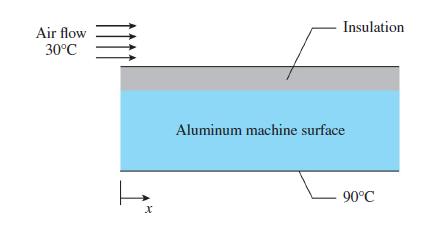Heat dissipated from a machine in operation can cause hot spots on its surface. Exposed hot spots
Question:
Heat dissipated from a machine in operation can cause hot spots on its surface. Exposed hot spots that are a potential to cause thermal burns on human skin tissue are considered to be hazards in the workplace. Consider a 1.5 m × 1.5 m flat machine surface that is made of a 5-mm-thick aluminum (k = 237 W/m ∙ K). During operation the machine inner aluminum surface temperature can be as high as 908C, while the outer surface is cooled with 30°C air flowing in parallel over it at 10 m/s. To prevent machine operators from thermal burns, the machine surface can be covered with insulation. The aluminum/insulation interface has a thermal contact conductance of 3000 W/m2 ∙ K. What is the thickness required of the insulation layer, with a thermal conductivity of 0.06 W/m ∙ K, in order to maintain the local outer surface temperature at 458C or lower? Using the EES (or other) software, plot the required insulation thickness and the local convection heat transfer coefficient along the outer surface in parallel with the air flow.
Step by Step Answer:

Heat And Mass Transfer Fundamentals And Applications
ISBN: 9780073398181
5th Edition
Authors: Yunus Cengel, Afshin Ghajar




